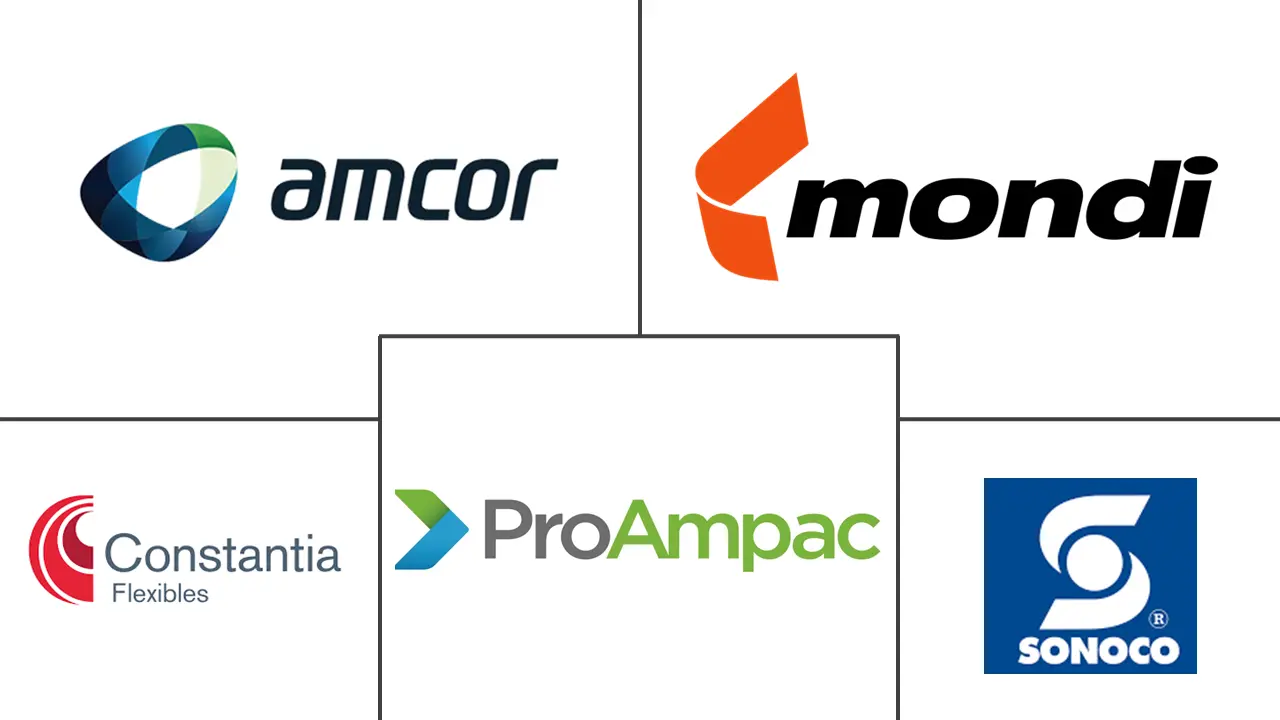Stand-Up Pouches Market Size and Share
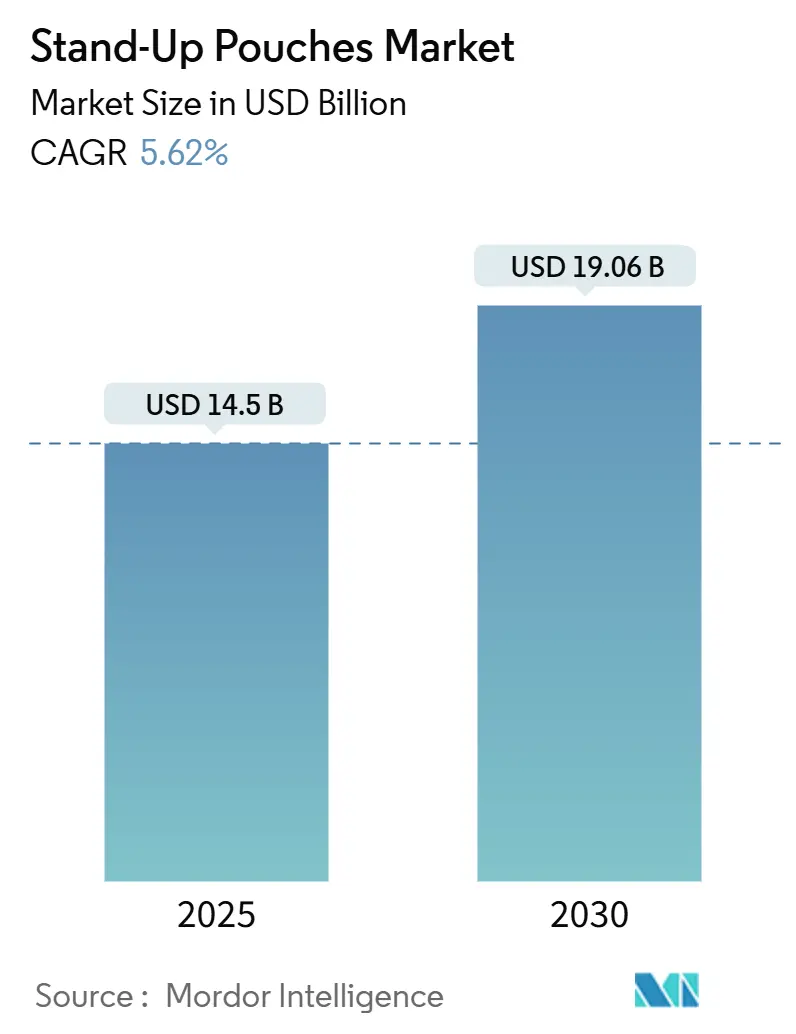
Stand-Up Pouches Market Analysis by Mordor Intelligence
The stand-up pouches market size reached USD 14.5 billion in 2024 and is forecast to expand to USD 19.06 billion by 2030, reflecting a 5.62% CAGR during 2025-2030. Rising demand for lightweight, resealable, and visually engaging packaging underpins this growth momentum. Regulatory reforms in Europe, functional-beverage innovation in East Asia, and a shift from rigid to flexible packaging among North American pet food brands are accelerating volume adoption. Early moves toward mono-material, recyclable formats provide manufacturers with cost and reputation advantages, while improvements in hot-fill and retort performance broaden end-use possibilities across the food, beverage, and household categories. Production scale in Asia-Pacific, technology upgrades in Latin America, and a vibrant M&A pipeline led by Amcor, Mondi, and Sonoco are redefining competitive boundaries as companies chase efficiency and circularity.
Key Report Takeaways
- By material, plastics led with a 71.89% market share of the stand-up pouches market in 2024; biodegradable alternatives are projected to post the fastest growth at a 7.14% CAGR through 2030.
- By product type, round-bottom formats generated 38.66% of the revenue in 2024, whereas corner-bottom styles are projected to grow at a 5.77% CAGR through 2030.
- By application, food and beverage accounted for 58.56% of the stand-up pouches market size in 2024; personal care shows the strongest 8.93% CAGR outlook.
- By distribution channel, direct sales captured 54.54% share of the stand-up pouches market in 2024, while indirect channels recorded a 6.36% CAGR through 2030.
- By region, the Asia-Pacific commanded 38.68% of the stand-up pouches market in 2024; the Middle East and Africa is the fastest-expanding region, with an 8.84% CAGR to 2030.
Global Stand-Up Pouches Market Trends and Insights
Drivers Impact Analysis
| Driver | (~) % Impact on CAGR Forecast | Geographic Relevance | Impact Timeline |
|---|---|---|---|
| Rapid shift to mono-material recyclable pouch structures in EU | +1.2% | Europe; spillover to North America | Medium term (2-4 years) |
| On-the-go functional beverage boom in East Asia | +0.9% | APAC core; global spillover | Short term (≤ 2 years) |
| Migration from metal cans to retort pouches for wet pet food | +0.8% | North America; expanding to Europe | Medium term (2-4 years) |
| Growth of aseptic dairy in Africa favoring aluminum-free pouches | +0.6% | Africa; Middle East expansion | Long term (≥ 4 years) |
| Nordic beauty e-commerce shift to refill SKUs | +0.4% | Northern Europe; spreading to developed markets | Medium term (2-4 years) |
| Brazilian CapEx surge in pouch-filling lines | +0.7% | South America; Latin America expansion | Short term (≤ 2 years) |
| Source: Mordor Intelligence | |||
Rapid Shift to Mono-Material Recyclable Pouch Structures in EU
The European Union Packaging and Packaging Waste Regulation, effective as of February 2025, requires all consumer packs to be recyclable by 2030 and to contain at least 30% post-consumer recycled content for plastics. Producers are rapidly transitioning from multi-layer aluminum structures to mono-material polyethylene films, which remain compatible with curbside recycling streams. Amcor’s Liquiflex AmPrima pouch meets these criteria and reports a 79% reduction in carbon emissions, alongside an 84% decrease in water use compared to legacy laminates. [1]Amcor, “Liquiflex AmPrima Launch,” amcor.com Brand owners who adopt early see lower extended producer responsibility fees and improved shelf-appeal messaging, while late movers face R&D cost spikes and possible loss of shelf space. The pivot strengthens the spouted pouches market as converters license new sealing technologies and downgauge films without compromising barrier integrity.
On-the-Go Functional Beverage Boom in East Asia Spurring Hot-Fill Pouches
East-Asian consumers are embracing protein shakes, vitamin gels, and meal-replacement drinks in portable portions. Hot-fill tolerance beyond 85 °C allows processors to skip preservatives, extend ambient shelf life, and deliver nutrient-dense formulas. Japan’s disaster-preparedness aisle now features Morinaga Seika’s five-year “in Jelly Energy Long Life” pouch, validating extreme barrier and retort performance expectations. Start-ups in South Korea triple their year-over-year sales by marketing single-serve spouts for protein mixes targeting female millennials. These breakthroughs inspire adoption in Southeast-Asian convenience stores and premium gyms, giving the stand-up pouches market fresh volume pipelines.
Migration from Metal Cans to Retort Pouches for Wet Pet Food in North America
Pet parents value portion control and resealability. Flexible retort pouches weigh up to 60% less than equivalent steel cans, reducing transport emissions. Sonoco’s multi-layer, clear-window retort pouch with post-consumer recycled content allows formulators to showcase diced meats and gravy while meeting thermal processing requirements.[2]Sonoco Products Company, “Retort and Hot Fill Pouch,” sonoco.com Nestlé Purina aims for 95% recyclable packaging by 2025, redirecting capital from metal lines to pouch automation. With wet pet food packaging worth USD 12.08 billion in 2023, every two-point share shift benefits the stand-up pouches market.
Growth of Aseptic Dairy Distribution in Africa Favoring Aluminum-Free Pouches
The lack of cold-chain coverage across Sub-Saharan Africa pushes dairy processors toward shelf-stable formats. SIG launched its Prime 55 system with a chemical-sterilization tunnel that simplifies line cleaning and supports an output of 24,000 pouches per hour. Aluminum-free retort films reduce material costs and enhance post-consumer recycling rates. Tetra Pak’s 200-milliliter Slim Leaf carton features 90% renewable content, setting an aspirational benchmark that pouch converters now strive to emulate.[3]Tetra Pak, “Aseptic Packaging FAQ,” tetrapak.com As milk consumption increases in secondary cities, demand for low-cost, low-footprint packaging drives incremental revenue into the stand-up pouch market.
Restraints Impact Analysis
| Restraint | (~) % Impact on CAGR Forecast | Geographic Relevance | Impact Timeline |
|---|---|---|---|
| Limited recycling streams for multi-layer laminates in U.S. | -0.8% | North America; global policy spillover | Long term (≥ 4 years) |
| Volatile EVOH & nylon resin prices squeezing APAC converters | -0.6% | APAC core; global supply-chain impact | Short term (≤ 2 years) |
| Brand-owner concerns over recycled-content migration | -0.4% | Global; food-contact packaging | Medium term (2-4 years) |
| Retort head-space failures in >1 L European soup packs | -0.3% | Europe; global technical standards | Medium term (2-4 years) |
| Source: Mordor Intelligence | |||
Limited Recycling Streams for Multi-Layer Laminates in United States
The U.S. requires USD 36–43 billion in infrastructure upgrades to lift plastics recycling rates to 61% by 2030. Until material recovery facilities can recognize and separate flexible laminates, brand owners hesitate to scale multilayer pouches. Producers are therefore accelerating the development of mono-materials, but transition costs and legacy equipment risks temporarily slow the growth of the stand-up pouches market.
Volatile EVOH & Nylon Resin Prices Squeezing APAC Converters
Asian resin spot prices fluctuated by 23% during 2024 as new polyethylene capacity came online, while geopolitical volatility impacted nylon supply chains. Margin compression forces small converters to defer cap-ex and negotiate shorter contracts, tempering output in price-sensitive consumer categories. Long-term supply pacts between global resin majors and integrated converters may help cushion volatility, but immediate uncertainty is suppressing expansion plans in the stand-up pouches market.
Segment Analysis
By Material Type: Plastic Dominance Drives Innovation
Plastic structures controlled 71.89% of the stand-up pouches market in 2024 as processors valued polyethylene’s sealability, polypropylene’s heat stability, and PET’s clarity. Biodegradable options are projected to record a 7.14% CAGR through 2030, driven by regulatory and consumer demand, while still addressing small-run SKUs. Accredo Packaging’s sugarcane-derived resin pouch offsets 43 grams of CO₂ per unit while offering drop-in machinability.
Meanwhile, Amcor’s AmFiber paper‐based barrier laminate targets snack producers searching for aluminum-free shelf life. Specialty EVOH barriers and nylon tie layers continue to protect oxygen-sensitive fillings, but cost spikes reposition them toward high-value nutraceutical lines. The stand-up pouches market size for biodegradable grades is projected to cross USD 1 billion by 2028, yet plastics will still anchor core food and beverage volumes. Evolving design-for-recycle guidelines stimulate rapid experimentation, positioning plastics as both incumbent and innovation canvas in the stand-up pouches market.
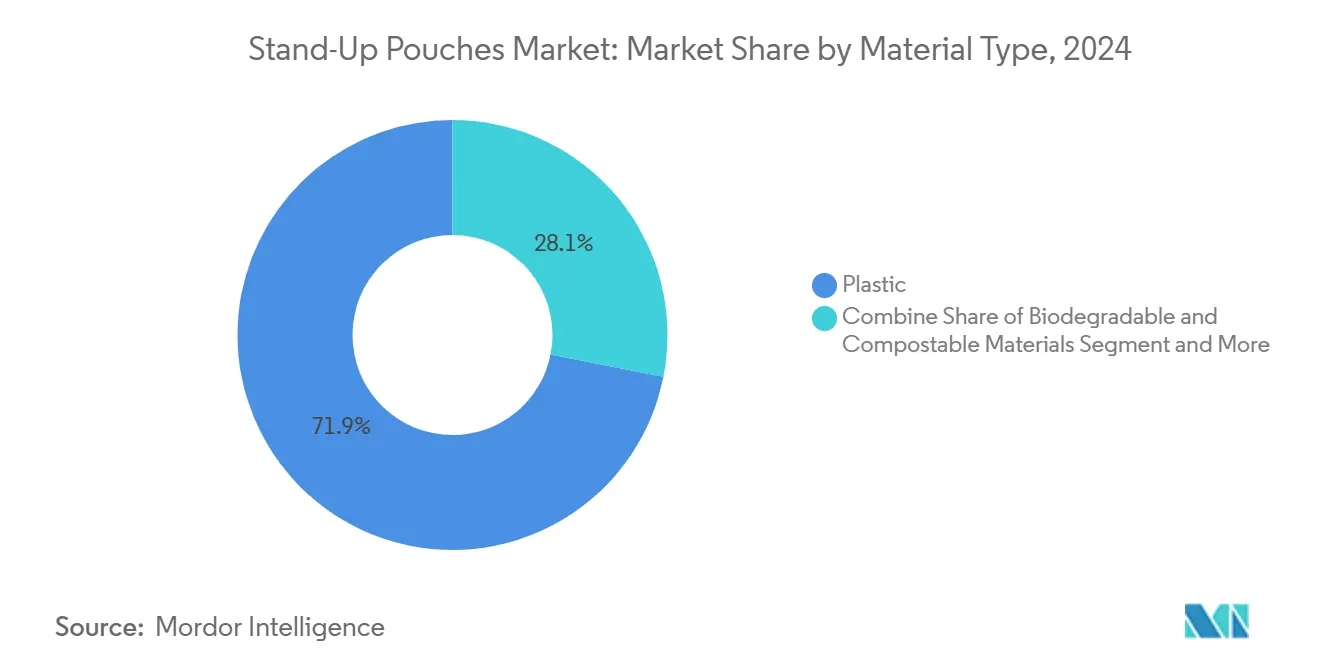
Note: Segment shares of all individual segments available upon report purchase
By Product Type: Round-Bottom Leadership Faces Corner Innovation
Round-bottom (Doyen) pouches accounted for a 38.66% revenue share in 2024, thanks to their mature forming equipment and broad application adoption. Corner-bottom designs, however, exhibit a 5.77% CAGR growth due to improved base stability, which supports larger fill volumes without requiring secondary cartons. K-Seal and Delta-Seal variants appeal to pharmaceutical fillers requiring tamper-evident integrity. Foodservice buyers are pursuing 2-L and 5-L corner-bottom pouches for sauces and condiments, citing pallet efficiency and 79% emission savings compared to HDPE bottles.
Nonetheless, technical challenges, chiefly headspace management during retort for SKUs exceeding 1 L, and slow migration in European soup lines, persist. Continuous R&D in gusset geometry and cap venting aims to minimize pressure differentials, promising to unlock new market share gains in the stand-up pouches market.
By Application: Food Dominance Expands Beyond Traditional Uses
Food and beverage applications accounted for 58.56% of the stand-up pouches market size in 2024, driven by a 50% penetration in fruit purées and more than 30% in baby foods. Personal care is growing at the fastest rate, with an 8.93% CAGR, benefiting from e-commerce penetration and refill pouches that reduce plastic weight by up to 65%. Healthcare formulations, including enteral nutrition and antibiotic suspensions, increasingly request gamma-sterilizable PE structures for precise dosing.
Pet care, capitalizing on the momentum of retort pouches, contributes to double-digit incremental volume growth. Industrial chemicals, lawn nutrients, and automotive fluids explore high-viscosity fitments, widening the end-use footprint and diversifying revenue lines in the stand-up pouches market.
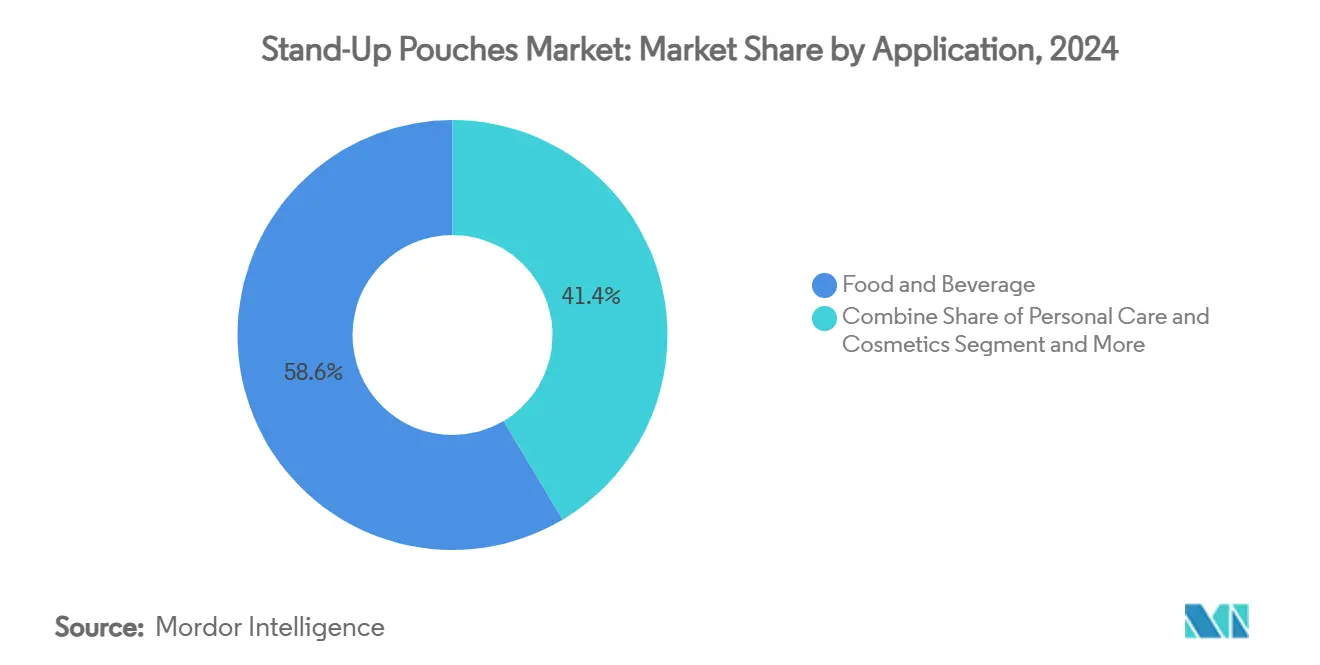
Note: Segment shares of all individual segments available upon report purchase
By Distribution Channel: Direct Sales Lead Digital Transformation
Direct sales retained 54.54% of 2024 shipments, as vertically integrated majors secure brand owners on multi-year supply contracts, guaranteeing consistent barrier specifications and print quality. Yet indirect channels grow at 6.36% CAGR as online configurators and regional distributors simplify low-volume, high-mix orders for craft brands. The digital integration of artwork upload, 3D mock-ups, and lead-time dashboards enhances transparency.
In Norway, the På(fyll) model demonstrates how direct-to-consumer fulfillment pairs subscription refills with emission tracking, widening consumer trust. Contract manufacturing of stand-up pouches now extends beyond forming, filling, and sealing to include recipe co-development, intensifying service differentiation across the stand-up pouch market.
Geography Analysis
Asia-Pacific dominated with 38.68% share of the stand-up pouches market in 2024, underpinned by China’s large-scale converting facilities, Japan’s hot-fill R&D, and South Korea’s premiumization playbook. Expected polyethylene oversupply, with 5 million tons of new capacity in 2025, is pressuring film pricing, offering converters raw-material leverage but compressing their margins. Amcor’s acquisition of Phoenix Flexibles in Gujarat expands its reach into India’s USD 20 million medical packaging niche and accelerates localized production.
North America leverages entrenched food-processing infrastructure and a pets-first culture to anchor steady demand. Infrastructure gaps loom large, with a USD 40 billion funding requirement to modernize material recovery facilities before 2030. Imminent 25% resin tariffs amplify cost pressures, yet they are also stimulating regional resin investment and trials using recycled resin. Coupled with California’s 2026 recyclable-content mandate, such policies push the stand-up pouches market toward mono-material PE retort formats.
Europe stands at the regulatory vanguard, compelling design-for-recycling across the stand-up pouches market. Early adopters, including Amcor, Mondi, and Bischof + Klein, have already commercialized PP and PE single-web pouches that meet the 30% PCR threshold and deliver 79% CO₂ cuts compared to PET/Alu/OPE triplex structures. Nordic refill programmes prove that consumer uptake can be rapid when lower-carbon packaging meets online convenience.
Latin America emerges as a capacity hotspot. Brazil registers 7.2% growth in the food industry, and PepsiCo’s USD 240 million plant upgrade will commission three eight-lane pouch fillers in 2025. Mexico and Colombia extend tax credits for circular-packaging investments, attracting multinational converters and opening export corridors into the United States under USMCA provisions.
The Middle East and Africa experience the fastest CAGR at 8.84%, led by aseptic milk, flavored water, and fruit nectar packed in aluminum-free pouches. SIG’s Prime 55 installation in Kenya and Tetra Pak’s promotional campaigns in Nigeria lower entry barriers. Energy-efficient sterilization and affordable fitment remain key success factors poised to drive regional growth within the stand-up pouches market.

Competitive Landscape
The stand-up pouches market is moderately fragmented. The top five converters control a signfiicant share of global revenue, leaving room for niche innovators. Sonoco’s USD 3.9 billion Eviosys purchase creates a metal-to-flexible crossover giant with synergistic R&D on dispensing closures. Amcor’s merger with Berry Global adds blown-film and cap-molding depth, enabling cradle-to-grave pack design that meets retailer recyclability scorecards.
Technology differentiation focuses on fully recyclable retort pouches. Amcor’s AmPrima RF flex-crystal structure replaces aluminum with EVOH and silica-oxide coatings, yet withstands 121 °C sterilization, delivering a 60% carbon-footprint drop. ExxonMobil promotes PE laminated webs that are compatible with existing PE recycling streams, while Dow and Mitsui advance solvent-free adhesives that ease delamination at recyclers.
Equipment suppliers consolidate to offer turnkey solutions: ProMach’s roll-up of HMC Products, MBF, and Zacmi integrates forming, filling, and pasteurization under one group, streamlining purchase decisions for fillers planning greenfield plants. Closure specialists broaden the value chain: Silgan’s USD 913 million Weener Packaging acquisition strengthens dispensing cap portfolios critical for larger format pouches.
Sustainability innovation remains the prime battleground. Accredo’s 100% bio-based sugarcane pouch secures contracts with vegan protein brands desiring carbon negativity. Gualapack’s plant in São Paulo combines extrusion, flexo print, and cap molding, cutting lead times for Brazilian CPGs aiming to redesign SKUs before 2026. These strategic moves elevate technology barriers and foster cross-regional knowledge transfer across the stand-up pouches market.
Stand-Up Pouches Industry Leaders
-
Mondi PLC
-
Sonoco Products Company
-
Constantia Flexibles GmbH
-
ProAmpac LLC
-
Amcor Plc
- *Disclaimer: Major Players sorted in no particular order
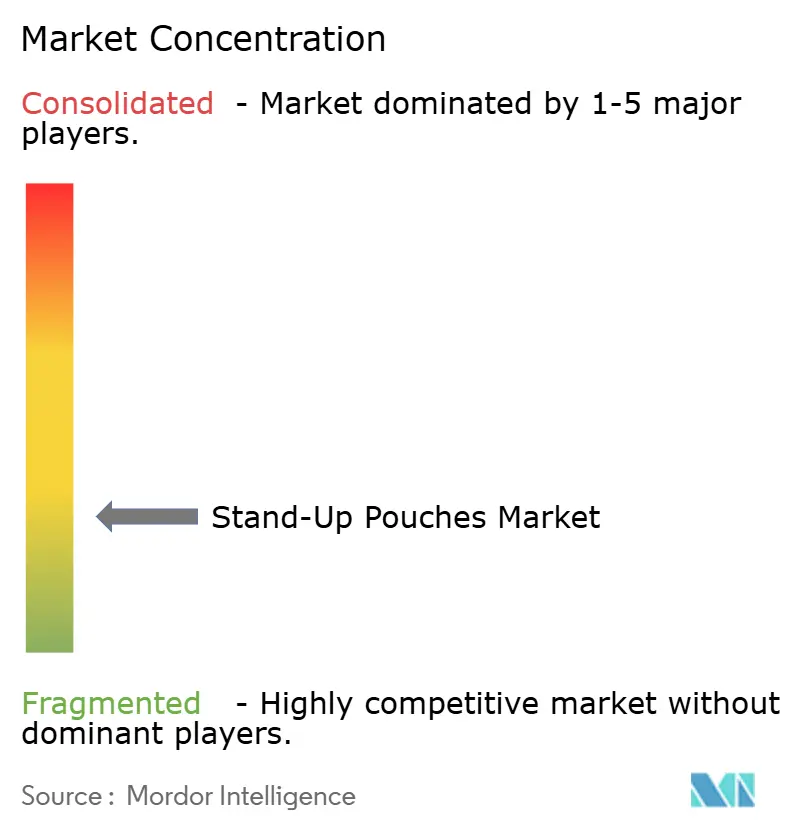
Recent Industry Developments
- April 2025: Amcor launched Liquiflex AmPrima mono-material pouches in European foodservice, achieving 79% carbon and 84% water savings.
- October 2024: Accredo unveiled the first 100% bio-based resin pouch at PACK EXPO International 2024.
- October 2024: ProMach acquired HMC Products, MBF, and Zacmi, reinforcing its integrated filling and processing portfolio.
- July 2024: Silgan agreed to acquire Weener Packaging for €838 million, expanding dispensing closure capability.
Global Stand-Up Pouches Market Report Scope
The Stand-Up Pouches Market Report is Segmented by Material Type (Plastic, Paper, Metal Foil, and Biodegradable and Compostable Materials), Product Type (Doyen/Round Bottom, K-Seal, Plow / Corner Bottomm and Other Product Types), Application (Food, Beverage, Personal Care and Cosmetics, Healthcare and Pharmaceuticals, Pet Care, and Other Application), Distribution Channel (Direct Sales, and Indirect Sales), and Geography (North America, Europe, South America, Asia Pacific, and Middle East and Africa). The Market Forecasts are Provided in Terms of Value (USD).
| Plastic | Polyethylene Terephthalate (PET) |
| Polyethylene (PE) | |
| Polypropylene (PP) | |
| Ethylene Vinyl Alcohol Copolymer (EVOH) | |
| Other Plastics | |
| Paper | |
| Metal Foil | |
| Biodegradable and Compostable Materials |
| Doyen / Round Bottom |
| K-Seal |
| Plow / Corner Bottom |
| Other Product Types |
| Food | Baked Food |
| Snacked Food | |
| Pet Food | |
| Confectionery | |
| Other Food | |
| Beverage | |
| Personal Care and Cosmetics | |
| Healthcare and Pharmaceuticals | |
| Pet Care | |
| Other Application |
| Direct Sales |
| Indirect Sales |
| North America | United States | |
| Canada | ||
| Mexico | ||
| Europe | Germany | |
| United Kingdom | ||
| France | ||
| Italy | ||
| Spain | ||
| Russia | ||
| Rest of Europe | ||
| Asia-Pacific | China | |
| India | ||
| Japan | ||
| South Korea | ||
| Australia and New Zealand | ||
| Rest of Asia-Pacific | ||
| Middle East and Africa | Middle East | United Arab Emirates |
| Saudi Arabia | ||
| Turkey | ||
| Rest of Middle East | ||
| Africa | South Africa | |
| Nigeria | ||
| Egypt | ||
| Rest of Africa | ||
| South America | Brazil | |
| Argentina | ||
| Rest of South America | ||
| By Material Type | Plastic | Polyethylene Terephthalate (PET) | |
| Polyethylene (PE) | |||
| Polypropylene (PP) | |||
| Ethylene Vinyl Alcohol Copolymer (EVOH) | |||
| Other Plastics | |||
| Paper | |||
| Metal Foil | |||
| Biodegradable and Compostable Materials | |||
| By Product Type | Doyen / Round Bottom | ||
| K-Seal | |||
| Plow / Corner Bottom | |||
| Other Product Types | |||
| By Application | Food | Baked Food | |
| Snacked Food | |||
| Pet Food | |||
| Confectionery | |||
| Other Food | |||
| Beverage | |||
| Personal Care and Cosmetics | |||
| Healthcare and Pharmaceuticals | |||
| Pet Care | |||
| Other Application | |||
| By Distribution Channel | Direct Sales | ||
| Indirect Sales | |||
| By Geography | North America | United States | |
| Canada | |||
| Mexico | |||
| Europe | Germany | ||
| United Kingdom | |||
| France | |||
| Italy | |||
| Spain | |||
| Russia | |||
| Rest of Europe | |||
| Asia-Pacific | China | ||
| India | |||
| Japan | |||
| South Korea | |||
| Australia and New Zealand | |||
| Rest of Asia-Pacific | |||
| Middle East and Africa | Middle East | United Arab Emirates | |
| Saudi Arabia | |||
| Turkey | |||
| Rest of Middle East | |||
| Africa | South Africa | ||
| Nigeria | |||
| Egypt | |||
| Rest of Africa | |||
| South America | Brazil | ||
| Argentina | |||
| Rest of South America | |||
Key Questions Answered in the Report
How big is the stand-up pouches market today?
The stand-up pouches market size reached USD 14.5 billion in 2024 and is projected to hit USD 19.06 billion by 2030, supported by a 5.62% CAGR.
Which region holds the largest share of the stand-up pouches market?
Asia-Pacific leads with 38.68% revenue share thanks to manufacturing scale in China, hot-fill innovation in Japan, and premium positioning in South Korea.
What is driving material innovation in stand-up pouches?
EU recyclability mandates and brand sustainability goals are accelerating the shift to mono-material polyethylene and bio-based resin structures that remain curbside recyclable.
Why are pet food brands moving from cans to stand-up pouches?
Pouches provide lighter weight, resealability, shelf impact, and carbon savings, aligning with pet-parent preferences and corporate recycling pledges.
Which application segment is growing fastest?
Personal care and cosmetics record the highest 8.93% CAGR as refill pouches enable e-commerce convenience and climate-impact reduction.
Page last updated on:
